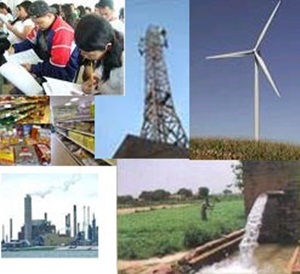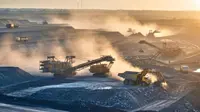Gross domestic product (GDP) of the country increased at a slower pace of 4.5 per cent in the second quarter of the current financial year (July-September 2019-20) against the 5.0 per cent growth recorded in the previous quarter (April-June 2019-20).

GDP at constant (2011-12) prices in Q2 of 2019-20 is estimated at Rs35,99,000 crore, against Rs34,43,000 crore in Q2 of 2018-19, showing a growth rate of 4.5 per cent, the weakest pace in more than six years.
Quarterly gross value addition (GVA) at constant basic (2011-2012) prices for Q2 of 2019-20 is estimated at Rs33,16,00 crore, against Rs31,79,000 crore in Q2 of 2018-19, showing a growth rate of 4.3 per cent over the corresponding quarter of the previous year.
Economic activities which recorded growth of over 4.3 per cent in Q2 of 2019-20 over Q2 of 2018-19 include ‘trade, hotels, transport, communication and services related to broadcasting’, ‘financial, real estate and professional services’ and ‘public administration, defence and other services’. Growth in the ‘agriculture, forestry and fishing’, ‘mining and quarrying’, ‘manufacturing’, ‘electricity, gas, water supply and other utility services’ and ‘construction’ is estimated to be 2.1 per cent, 0.1 per cent, (-) 1.0 per cent, 3.6 per cent and 3.3 per cent, respectively during this period.
The economy has been hit by weak consumer demand, slowing factory activities and negative impacts of the prolonged monsoon, according to data released by the government on Friday.
The second quarter estimates are based on the first advance estimates of agricultural production during Kharif season of 2019-20.
Quarterly GVA at basic prices for Q2 2019-20 from ‘agriculture, forestry and fishing’ sector grew by 2.1 per cent compared to a growth rate of 4.9 per cent in Q2 of 2018-19.
Quarterly GVA at basic prices for Q2 2019-20 from ‘mining and quarrying’ sector grew by 0.1 per cent as compared to growth of (-) 2.2 per cent in Q2 of 2018-19. The key indicators of mining sector, namely, production of coal, crude oil and natural gas and IIP mining registered growth rates of (-) 10.3 per cent, (- 5.1 per cent, (-) 2.6 per cent and (-) 1.2 per cent, during Q2 of 2019-20 compared to 6.2 per cent, (-) 4.4 per cent, (-) 2.0 per cent and 0.9 per cent, respectively, during Q2 of 2018-19.
Quarterly GVA at basic prices for Q2 of 2019-20 from ‘manufacturing’ sector grew by (-) 1.0 per cent compared to growth of 6.9 per cent in Q2 of 2018-19.
According to the data released by National Statistical Office (NSO), the gross value added (GVA) growth in the manufacturing sector contracted by 1 per cent in the second quarter of this fiscal from 6.9 per cent expansion a year ago. Similarly, farm sector GVA growth remained subdued at 2.1 per cent, down from 4.9 percent in the corresponding period of the previous fiscal.
Construction sector GVA growth too slowed to 3.3 per cent from 8.5 per cent earlier. Mining sector growth was recorded at 0.1 per cent as against 2.2 per cent contraction a year ago.
Electricity, gas, water supply and other utility services growth also slowed to 3.6 per cent from 8.7 per cent a year ago. Similarly, trade, hotel, transport, communication and services related to broadcasting growth was also down to 4.8 per cent in the second quarter from 6.9 per cent a year ago.
Financial, real estate and professional services growth slowed to 5.8 per cent in the Q2 FY2019-20 from 7 per cent a year ago. On the other hand, public administration, defence and other services reported improvement with an 11.6 per cent rise during the quarter under review from 8.6 per cent a year earlier.
On a half-yearly basis (April-September 2019), GDP growth came in at 4.8 per cent as compared to 7.5 per cent in the same period a year ago. "GDP at constant (2011-12) prices in Q2 of 2019-20 is estimated at Rs35,99,000 crore, against Rs34,43,000 crore in Q2 of 2018-19, showing a growth rate of 4.5 per cent," an NSO statement said.
Gross Fixed Capital Formation (GFCF), which is a barometer of investment, at constant (2011-2012) prices, estimated at Rs10,83,000 crore in Q2 of 2019-20 against Rs11,16,000 crore in Q2 of 2018-19.
In terms of GDP, the rates of GFCF at current and constant (2011-2012) prices during Q2 of 2019-20 are estimated at 27.3 per cent and 30.1 per cent, respectively, as against the corresponding rates of 29.2 per cent and 32.4 per cent, respectively, in Q2 of 2018-19.
"Growth rates of GFCF at current and constant prices are estimated at (-) 0.9 per cent and (-) 3.0 per cent during Q2 of 2019-20 compared to 16.2 per cent and 11.8 per cent during Q2 of 2018-19," it added.
Macroeconomic data released earlier this month also indicated a severe slowdown in the economic activities. Industrial production shrank by 4.3 per cent in September, registering the weakest performance in seven years due to output decline in manufacturing, mining and electricity sectors.
Extended monsoon seasons, particularly heavy rains in October and November, have damaged crops in several parts of India. This has also resulted in rising prices of vegetables such as onions and tomatoes in the last two months, accelerating food inflation to nearly 8 per cent in October from a year ago.























